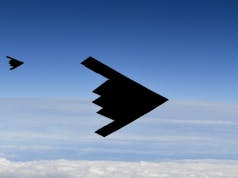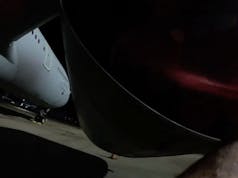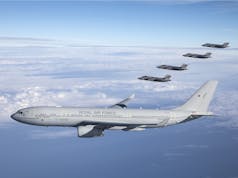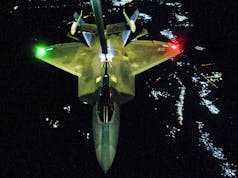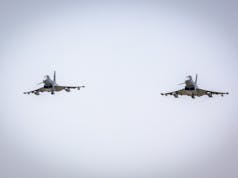Royal Air Force aircraft have continued to fly extensive armed reconnaissance patrols across Iraq and Syria to identify remaining Islamic State positions.
On Thursday 9 November, two Tornados used a Brimstone missile and two Paveway IVs to destroy a vehicle and stockpiled supplies in the deserts of western Iraq.
A pair of Typhoons patrolled over northern Iraq on Saturday 11 November. Three improvised explosive devices had been identified, dug into embankments alongside roads around twenty miles north-west of Bayji, and the Typhoons were tasked with the safe destruction of these deadly booby-traps. Each was hit in turn with a Paveway IV.
The following day, a Reaper remotely piloted aircraft operating over eastern Syria similarly disposed of another booby-trap left behind by the terrorists – an armoured truck-bomb parked on the edge of a road some twenty miles south-east of Al Mayadin. This was struck by a GBU-12 guided bomb and destroyed.
What is the status of the air campaign?
The UK has been the second largest contributor to the air campaign in Iraq and Syria. UK aircraft have flown over 3,000 missions as part of Operation Shader, and as of the beginning of November 2016 had conducted 1,115 airstrikes against ISIS targets in Iraq and Syria (1,048 and 67 respectively).
In July 2016 the MoD acknowledged that “the RAF has not operated at this sustained operational tempo in a single theatre of conflict for a quarter of a century”.
The Government has consistently maintained that no civilian casualties in Iraq or Syria, to date, have resulted from UK air strikes however it adds “no military operations come without risk, particularly in dense urban environments and against such inhuman Daesh tactics, the RAF continues to take all steps necessary to minimise civilian casualties.”
In December 2016, it was reported that the Royal Air Force is operating at its most intense for 25 years in a single theatre of operation which far outstripped the UK involvement in Iraq and Afghanistan – RAF jets have dropped 11 times more bombs (1,276 strikes) on Syria and Iraq in the preceding 12 months than they had in the busiest year of action in Afghanistan a decade previously.
The cost of the operations against Islamic State and other details of the campaign were revealed in a briefing paper. In March 2015 the MoD confirmed that the net additional costs of the military air operation would be met from the Treasury Special Reserve; while the costs of training and equipping the Iraqi and Kurdish security forces, and the provision of key enablers, would be met from the MOD’s Deployed Military Activity Pool (DMAP).
In answer to a parliamentary question in September 2016 the MoD set the costs of the operation, between August 2014 and the 31st of March 2016, at £265 million (£45 million in the 2014-15 financial year, and £220 million in the 2015-16 financial year).


